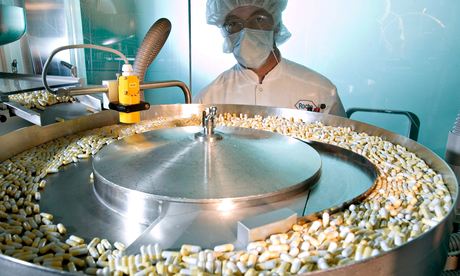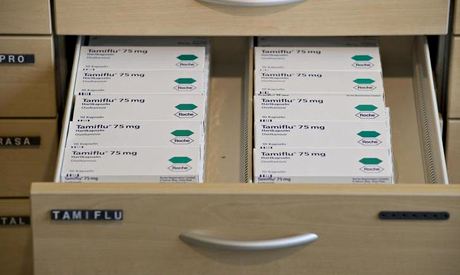What the Tamiflu saga tells us about drug trials and big pharma
We
now know the government's Tamiflu stockpile wouldn't have done us much
good in the event of a flu epidemic. But the secrecy surrounding
clinical trials means there's a lot we don't know about other medicines
we take

Tamiflu capsules. Photograph: Per Lindgren/REX
Today
we found out that Tamiflu doesn't work so well after all. Roche, the
drug company behind it, withheld vital information on its clinical
trials for half a decade, but the Cochrane Collaboration,
a global not-for-profit organisation of 14,000 academics, finally
obtained all the information. Putting the evidence together, it has
found that Tamiflu has little or no impact on complications of flu infection, such as pneumonia.
That is a scandal because the UK government spent £0.5bn stockpiling this drug in the hope that it would help prevent serious side-effects from flu infection. But the bigger scandal is that Roche broke no law by withholding vital information on how well its drug works. In fact, the methods and results of clinical trials on the drugs we use today are still routinely and legally being withheld from doctors, researchers and patients. It is simple bad luck for Roche that Tamiflu became, arbitrarily, the poster child for the missing-data story.
And it is a great poster child. The battle over Tamiflu perfectly illustrates the need for full transparency around clinical trials, the importance of access to obscure documentation, and the failure of the regulatory system. Crucially, it is also an illustration of how science, at its best, is built on transparency and openness to criticism, because the saga of the Cochrane Tamiflu review began with a simple online comment.
In 2009, there was widespread concern about a new flu pandemic, and billions were being spent stockpiling Tamiflu around the world. Because of this, the UK and Australian governments specifically asked the Cochrane Collaboration to update its earlier reviews on the drug. Cochrane reviews are the gold-standard in medicine: they summarise all the data on a given treatment, and they are in a constant review cycle, because evidence changes over time as new trials are published. This should have been a pretty everyday piece of work: the previous review, in 2008, had found some evidence that Tamiflu does, indeed, reduce the rate of complications such as pneumonia. But then a Japanese paediatrician called Keiji Hayashi left a comment that would trigger a revolution in our understanding of how evidence-based medicine should work. This wasn't in a publication, or even a letter: it was a simple online comment, posted informally underneath the Tamiflu review on the Cochrane website, almost like a blog comment.

The UK government spent £0.5bn stockpiling Tamiflu. Photograph: Hanodut/EPA
That is a scandal because the UK government spent £0.5bn stockpiling this drug in the hope that it would help prevent serious side-effects from flu infection. But the bigger scandal is that Roche broke no law by withholding vital information on how well its drug works. In fact, the methods and results of clinical trials on the drugs we use today are still routinely and legally being withheld from doctors, researchers and patients. It is simple bad luck for Roche that Tamiflu became, arbitrarily, the poster child for the missing-data story.
And it is a great poster child. The battle over Tamiflu perfectly illustrates the need for full transparency around clinical trials, the importance of access to obscure documentation, and the failure of the regulatory system. Crucially, it is also an illustration of how science, at its best, is built on transparency and openness to criticism, because the saga of the Cochrane Tamiflu review began with a simple online comment.
In 2009, there was widespread concern about a new flu pandemic, and billions were being spent stockpiling Tamiflu around the world. Because of this, the UK and Australian governments specifically asked the Cochrane Collaboration to update its earlier reviews on the drug. Cochrane reviews are the gold-standard in medicine: they summarise all the data on a given treatment, and they are in a constant review cycle, because evidence changes over time as new trials are published. This should have been a pretty everyday piece of work: the previous review, in 2008, had found some evidence that Tamiflu does, indeed, reduce the rate of complications such as pneumonia. But then a Japanese paediatrician called Keiji Hayashi left a comment that would trigger a revolution in our understanding of how evidence-based medicine should work. This wasn't in a publication, or even a letter: it was a simple online comment, posted informally underneath the Tamiflu review on the Cochrane website, almost like a blog comment.

The UK government spent £0.5bn stockpiling Tamiflu. Photograph: Hanodut/EPA
Cochrane
had summarised the data from all the trials, explained Hayashi, but its
positive conclusion was driven by data from just one of the papers it
cited: an industry-funded summary of 10 previous trials, led by an
author called Kaiser. From these 10 trials, only two had ever been
published in the scientific literature. For the remaining eight, the
only available information on the methods used came from the brief
summary in this secondary source, created by industry. That's not
reliable enough.
This is science at its best. The Cochrane review is readily accessible online; it explains transparently the methods by which it looked for trials, and then analysed them, so any informed reader can pull the review apart, and understand where the conclusions came from. Cochrane provides an easy way for readers to raise criticisms. And, crucially, these criticisms did not fall on deaf ears. Dr Tom Jefferson is the head of the Cochrane respiratory group, and the lead author on the 2008 review. He realised immediately that he had made a mistake in blindly trusting the Kaiser data. He said so, without defensiveness, and then set about getting the information needed.
First, the Cochrane researchers wrote to the authors of the Kaiser paper. By reply, they were told that this team no longer had the files: they should contact Roche. Here the problems began. Roche said it would hand over some information, but the Cochrane reviewers would need to sign a confidentiality agreement. This was tricky: Cochrane reviews are built around showing their working, but Roche's proposed contract would require them to keep the information behind their reasoning secret from readers. More than this, the contract said they were not allowed to discuss the terms of their secrecy agreement, or publicly acknowledge that it even existed. Roche was demanding a secret contract, with secret terms, requiring secrecy about the methods and results of trials, in a discussion about the safety and efficacy of a drug that has been taken by hundreds of thousands of people around the world, and on which governments had spent billions. Roche's demand, worryingly, is not unusual. At this point, many in medicine would either acquiesce, or give up. Jefferson asked Roche for clarification about why the contract was necessary. He never received a reply.
Then, in October 2009, the company changed tack. It would like to hand over the data, it explained, but another academic review on Tamiflu was being conducted elsewhere. Roche had given this other group the study reports, so Cochrane couldn't have them. This was a non-sequitur: there is no reason why many groups should not all work on the same question. In fact, since replication is the cornerstone of good science, this would be actively desirable.
Then, one week later, unannounced, Roche sent seven documents, each around a dozen pages long. These contained excerpts of internal company documents on each of the clinical trials in the Kaiser meta-analysis. It was a start, but nothing like the information Cochrane needed to assess the benefits, or the rate of adverse events, or fully to understand the design of the trials.

Packets of Tamiflu in a drawer at a German pharmacy. Photograph: Wolfgang Rattay/Reuters
At the same time, it was rapidly becoming clear that there were odd inconsistencies in the information on this drug. Crucially, different organisations around the world had drawn vastly different conclusions about its effectiveness. The US Food and Drug Administration (FDA) said it gave no benefits on complications such as pneumonia, while the US Centers for Disease Control and Prevention said it did. The Japanese regulator made no claim for complications, but the European Medicines Agency (EMA) said there was a benefit. There are only two explanations for this, and both can only be resolved by full transparency. Either these organisations saw different data, in which case we need to build a collective list, add up all the trials, and work out the effects of the drug overall. Or this is a close call, and there is reasonable disagreement on how to interpret the trials, in which case we need full access to their methods and results, for an informed public debate in the medical academic community.
This is particularly important, since there can often be shortcomings in the design of a clinical trial, which mean it is no longer a fair test of which treatment is best. We now know this was the case in many of the Tamiflu trials, where, for example, participants were sometimes very unrepresentative of real-world patients. Similarly, in trials described as "double blinded" – where neither doctor nor patient should be able to tell whether they're getting a placebo or the real drug – the active and placebo pills were different colours. Even more oddly, in almost all Tamiflu trials, it seems a diagnosis of pneumonia was measured by patients' self-reporting: many researchers would have expected a clear diagnostic algorithm, perhaps a chest x-ray, at least.
Since the Cochrane team were still being denied the information needed to spot these flaws, they decided to exclude all this data from their analysis, leaving the review in limbo. It was published in December 2009, with a note explaining their reasoning, and a small flurry of activity followed. Roche posted their brief excerpts online, and committed to make full study reports available. For four years, they then failed to do so.
Read More Here
.....
The dispute over the benefits of Tamiflu, and to a lesser extent of GlaxoSmithKline's flu drug Relenza, blew up with the joint publication by the respected Cochrane Review research network and the British Medical Journal of an analysis of trial data, which found no good evidence behind claims the drugs cut hospital admissions or reduce flu complications.
The review's main findings were that the medicines had few if any beneficial effects, but did have adverse side effects that were previously dismissed or overlooked.
"Remember, the idea of a drug is that the benefits should exceed the harms," says Carl Heneghan, one of the lead investigators of the Cochrane review and a professor of evidence-based medicine at Britain's Oxford University. "So if you can't find any benefits, that accentuates the harms."
But Roche, which has been under fire for several years over its refusal to allow the Cochrane team unrestricted access to Tamiflu data, rejected the findings, saying it "fundamentally disagrees with the overall conclusions" of their study.
"We firmly stand by the quality and integrity of our data, reflected in decisions reached by 100 regulators across the world and subsequent real-world evidence demonstrating that Tamiflu is an effective medicine in the treatment and prevention of influenza," it says in a statement.
Tamiflu sales hit almost $3 billion in 2009 — mostly due to its use in the H1N1 flu pandemic — but they have since declined.
The drug, one of a class of medicines known as neuraminidase inhibitors, is approved by regulators worldwide and is stockpiled in preparation for a potential global flu outbreak. It is also on the World Health Organisation's "essential medicines" list.
Read More Here
.....
This is science at its best. The Cochrane review is readily accessible online; it explains transparently the methods by which it looked for trials, and then analysed them, so any informed reader can pull the review apart, and understand where the conclusions came from. Cochrane provides an easy way for readers to raise criticisms. And, crucially, these criticisms did not fall on deaf ears. Dr Tom Jefferson is the head of the Cochrane respiratory group, and the lead author on the 2008 review. He realised immediately that he had made a mistake in blindly trusting the Kaiser data. He said so, without defensiveness, and then set about getting the information needed.
First, the Cochrane researchers wrote to the authors of the Kaiser paper. By reply, they were told that this team no longer had the files: they should contact Roche. Here the problems began. Roche said it would hand over some information, but the Cochrane reviewers would need to sign a confidentiality agreement. This was tricky: Cochrane reviews are built around showing their working, but Roche's proposed contract would require them to keep the information behind their reasoning secret from readers. More than this, the contract said they were not allowed to discuss the terms of their secrecy agreement, or publicly acknowledge that it even existed. Roche was demanding a secret contract, with secret terms, requiring secrecy about the methods and results of trials, in a discussion about the safety and efficacy of a drug that has been taken by hundreds of thousands of people around the world, and on which governments had spent billions. Roche's demand, worryingly, is not unusual. At this point, many in medicine would either acquiesce, or give up. Jefferson asked Roche for clarification about why the contract was necessary. He never received a reply.
Then, in October 2009, the company changed tack. It would like to hand over the data, it explained, but another academic review on Tamiflu was being conducted elsewhere. Roche had given this other group the study reports, so Cochrane couldn't have them. This was a non-sequitur: there is no reason why many groups should not all work on the same question. In fact, since replication is the cornerstone of good science, this would be actively desirable.
Then, one week later, unannounced, Roche sent seven documents, each around a dozen pages long. These contained excerpts of internal company documents on each of the clinical trials in the Kaiser meta-analysis. It was a start, but nothing like the information Cochrane needed to assess the benefits, or the rate of adverse events, or fully to understand the design of the trials.

Packets of Tamiflu in a drawer at a German pharmacy. Photograph: Wolfgang Rattay/Reuters
At the same time, it was rapidly becoming clear that there were odd inconsistencies in the information on this drug. Crucially, different organisations around the world had drawn vastly different conclusions about its effectiveness. The US Food and Drug Administration (FDA) said it gave no benefits on complications such as pneumonia, while the US Centers for Disease Control and Prevention said it did. The Japanese regulator made no claim for complications, but the European Medicines Agency (EMA) said there was a benefit. There are only two explanations for this, and both can only be resolved by full transparency. Either these organisations saw different data, in which case we need to build a collective list, add up all the trials, and work out the effects of the drug overall. Or this is a close call, and there is reasonable disagreement on how to interpret the trials, in which case we need full access to their methods and results, for an informed public debate in the medical academic community.
This is particularly important, since there can often be shortcomings in the design of a clinical trial, which mean it is no longer a fair test of which treatment is best. We now know this was the case in many of the Tamiflu trials, where, for example, participants were sometimes very unrepresentative of real-world patients. Similarly, in trials described as "double blinded" – where neither doctor nor patient should be able to tell whether they're getting a placebo or the real drug – the active and placebo pills were different colours. Even more oddly, in almost all Tamiflu trials, it seems a diagnosis of pneumonia was measured by patients' self-reporting: many researchers would have expected a clear diagnostic algorithm, perhaps a chest x-ray, at least.
Since the Cochrane team were still being denied the information needed to spot these flaws, they decided to exclude all this data from their analysis, leaving the review in limbo. It was published in December 2009, with a note explaining their reasoning, and a small flurry of activity followed. Roche posted their brief excerpts online, and committed to make full study reports available. For four years, they then failed to do so.
Read More Here
.....
Row erupts over influenza drug Tamiflu
Governments
who stockpile the anti-flu medicine Tamiflu are wasting billions of
dollars on a drug whose effectiveness is in doubt, according to a new
study.
The row has drawn in the drugmaker Roche, as well as
industry regulators and independent scientists. Supporters of Tamiflu
says the review's conclusions are flawed and insiste the drug is both
safe and effective.The dispute over the benefits of Tamiflu, and to a lesser extent of GlaxoSmithKline's flu drug Relenza, blew up with the joint publication by the respected Cochrane Review research network and the British Medical Journal of an analysis of trial data, which found no good evidence behind claims the drugs cut hospital admissions or reduce flu complications.
The review's main findings were that the medicines had few if any beneficial effects, but did have adverse side effects that were previously dismissed or overlooked.
"Remember, the idea of a drug is that the benefits should exceed the harms," says Carl Heneghan, one of the lead investigators of the Cochrane review and a professor of evidence-based medicine at Britain's Oxford University. "So if you can't find any benefits, that accentuates the harms."
But Roche, which has been under fire for several years over its refusal to allow the Cochrane team unrestricted access to Tamiflu data, rejected the findings, saying it "fundamentally disagrees with the overall conclusions" of their study.
"We firmly stand by the quality and integrity of our data, reflected in decisions reached by 100 regulators across the world and subsequent real-world evidence demonstrating that Tamiflu is an effective medicine in the treatment and prevention of influenza," it says in a statement.
Tamiflu sales hit almost $3 billion in 2009 — mostly due to its use in the H1N1 flu pandemic — but they have since declined.
The drug, one of a class of medicines known as neuraminidase inhibitors, is approved by regulators worldwide and is stockpiled in preparation for a potential global flu outbreak. It is also on the World Health Organisation's "essential medicines" list.
Read More Here
.....







No comments:
Post a Comment
Hello and thank you for visiting my blog. Please share your thoughts and leave a comment :)